啦啦啦, 今天开始我们来复习iOS面试中重要的一块知识点:Objective-C(OC). OC是iOS开发的大头, 虽然很多新的代码建议大家用Swift, 还是有很多很多legacy code还是用的OC, 特别是大厂的大App.
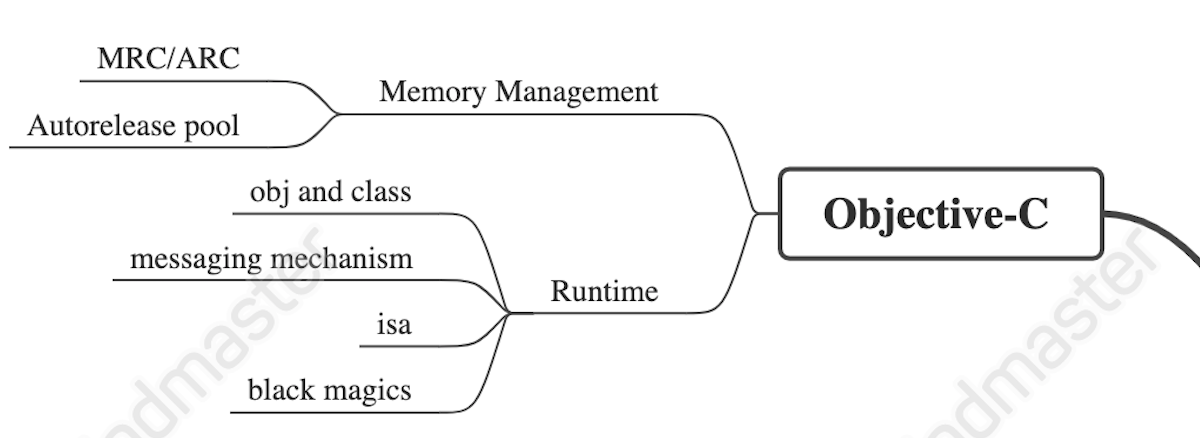
因为ObjC东西太多了, 我只能把内容分成几个部分. 这篇就着重复习ObjC的内存管理Memory Management. 有些没能展开细讲的知识点, 我会附上一些相关博客链接供大家查阅. 文章的形式我就以英文问答的形式吧, 模拟英文面试, 习惯中文的小伙伴也可以趁机练练英文阅读.
废话不多说, 黑喂狗!
Objective-C Memory Management Q&A
Q: What are the different kinds of memory area in Objective-C (or in general)?
A: Normally there are 5 different memory area:
- Stack: memory managed by compiler and created at runtime. Declared basic types such as integers/pointers are pushed to stack. Stack memory are popped when exit function. Each thread has its own stack.
- Heap: memory managed by programmer and created at runtime. Objects are stored in heap and we keep pointers to them. Programmer needs to manually allocate heap memory and deallocate it if neccessary. Every thread shares one heap memory.
- BSS: memory managed by compiler and created at compile time. Declared static/global variables are stored here. The memory is created once during execution of the program.
- Constant area: similar to BSS except all initialized constant are stored in this area. e.g.
static int a;will be in BSS andstatic int a =3;is stored in constant area. - **Code area **: stored compiled binary code.
Q: What is Reference Counting in Objective-C?
A: Reference counting is a way of the system to manage memory, which is by keeping a number of times an object is referred to by other pointers. If the reference count of an object is zero, the system will release its memory at some point of time.
Follow up: Tell me the difference between MRC and ARC?
A: MRC is short for Manual Reference Counting and ARC is automatic reference counting. Because in Objective-C, almost all object are heap allocated and its developer’s responsibility to correctly manage the memory. Before OC5.0, it’s manual, hence Manual Reference Counting. For example, We use [obj retain] to tell the runtime we increase the reference count, and [obj release] to reduce reference count. After OC5.0, ARC comes and these things are managed by compiler, we no longer need to do that by ourselves.
Q: Explain retain cycle and how to avoid it?
A: As I mentioned before, objects will only be released if their reference count become 0. Retain cycle happens if two or more objects hold strong reference to each other, which form a cycle, thus their reference count can never be 0. For example, a common retain cycle is a ViewController holds a strong reference to block which is a network API callback. If the block capture self strongly, then you have a retain cycle. A way to resolve it is to declare a weak self and let block capture the weak self instead.
Follow up 1: How do you detect retain cycle?
A: There are multiple techniques can be used. For example:
- FBRetainCycleDetector
- Symbolic breakpoint
- Instruments Memory Graph
- Instruments Allocation and Leaks
More on this in here, here and here.
Follow up 2: Explain how improper use of NSTimer can lead to retain cycle? How to solve it?
A: If we use the API [NSTimer scheduleWithTarget: selector:], NSTimer will hold strong reference to its target. If you fire a NSTimer in a ViewController and the ViewController hold strong reference to it, it will be a reference cycle. You have to invalidate the timer and set the reference to nil. Or we can use another API [NSTimer scheduledTimerWithTimeInterval: repeats:block:], as long as we use weak self , there won’t be retain cycle.
Follow up 3: What if your UIViewController don’t hold strong reference to the NSTimer?
A: There will still be a memory leak. UIViewController will not be dealloc. Because NSRunLoop will hold strong ref to NSTimer, NSTimer holds ref to UIViewController.
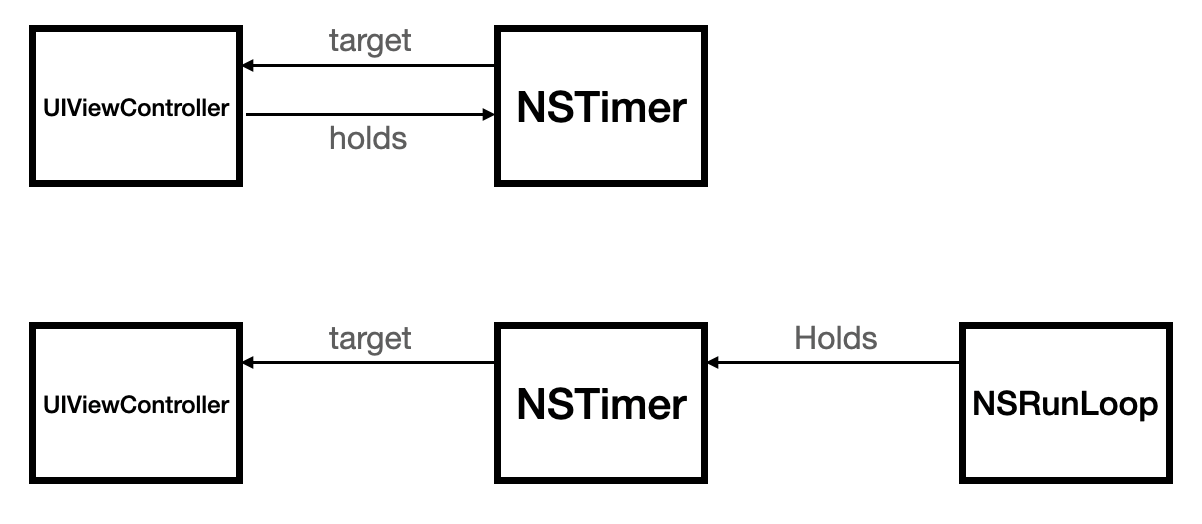
Q: Explain difference and usage of weak, strong , assign?
A: They are property modifiers, which describe different reference types of the pointer . strong and weak are pointer types for objects and assign is for basic types. Basic types are stack-allocated which are automatically managed by the system; ObjC objects are heap-allocated which should be managed by developer. mostly strong means that the current object will hold strong reference to the ivar, which leads the reference count for the ivar to increase by 1. weak on the other hand would not affect the ivar’s reference count. Moreover, if the ivar is deallocated, the weak pointer will be set to nil.
Follow up 1: Can you use assign to an object? Why so or why not so?
A: Technically you can use assign for object. But the problem is the system won’t set the pointer to nil after deallocating the referred object. So if you try to use the same pointer, it will cause a EXC_BAD_ACCESS runtime error, which essentially says that you are accessing a wild pointer.
For example, say you have a VC which has a UIButton property:
@interface ViewController
@property(nonatomic, assign) UIButton *btn;
@end Then you create a UIButton and assign to the VC:
UIButton *btn = [[UIButton alloc] initWithFrame:....];
vc.btn = btn;
btn = nil;
//later, somewhere else
NSLog(@"%@", vc.btn); //Error. EXC_BAD_ACCESS (code=....)Follow up 2: Do you know how the system implements weak pointer? Namely how a weak pointer be set to nil after the object being deallocated?
A: In principle, the runtime will hold a weak pointer mapping table, whose keys are object memory address and values are lists of weak pointer addresses who point to the object. Everytime, you assign let a weak pointer points to an object, the system will add the pointer list for the corresponding object. When the object is deallocated, the runtime will lookup its memory address, get the weak pointer list, and set them all to nil.
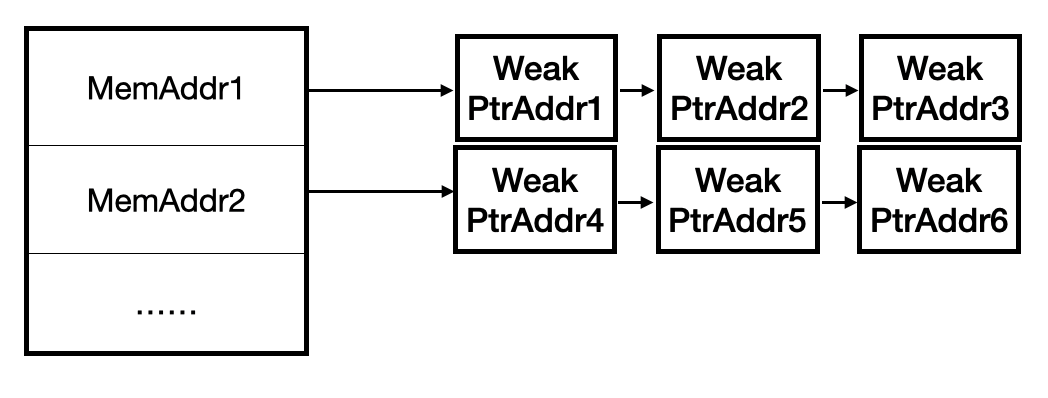
More on this in here,
Q: What is AutoReleasePool and why we need it?
A: AutoReleasePool is memory managing mechanism. It’s a way of keeping an object around you are not sure when to release it.
Whenever an object instance is marked as “autoreleased” (e.g NSArray* arry = [[NSArray array] autorelease];), it will have a retain count of +1 at that moment in time. And the object is add to AutoReleasePool. At the end of the run loop, the pool is drained, and any object marked autorelease then has its retain count decremented. But with ARC, developer not longer needs to manually call [obj autorelease], but only needs to enclose the code using @autoreleasepool{}
Follow up 1: Do you know how it’s implemented?
@autoreleasepool{} can be loosely translate into:
```
@autoreleasepool {
void *ctx = objc_autoreleasePoolPush(){
void *objc_autoreleasePoolPush(void)
|
void *AutoreleasePoolPage::push(void)
};
objc_autoreleasePoolPop(ctx){
void objc_autoreleasePoolPop(void *ctxt)
|
AutoreleasePoolPage::pop(void *ctxt)
};
```AutoReleasedPool is implemented by a doublly-link list of a struct called AutoReleasePoolPage. Each AutoReleasePool holds a stack, every autorelease object will be push to the current AutoReleasePage’s stack. Each AutoReleasePoolPage has fixed memory size, so if there are too many autorelease objects in one’s stack, system will create one new AutoReleasePoolPage, push the object to its stack and add the new AutoReleasePoolPage to the doubly-link list.
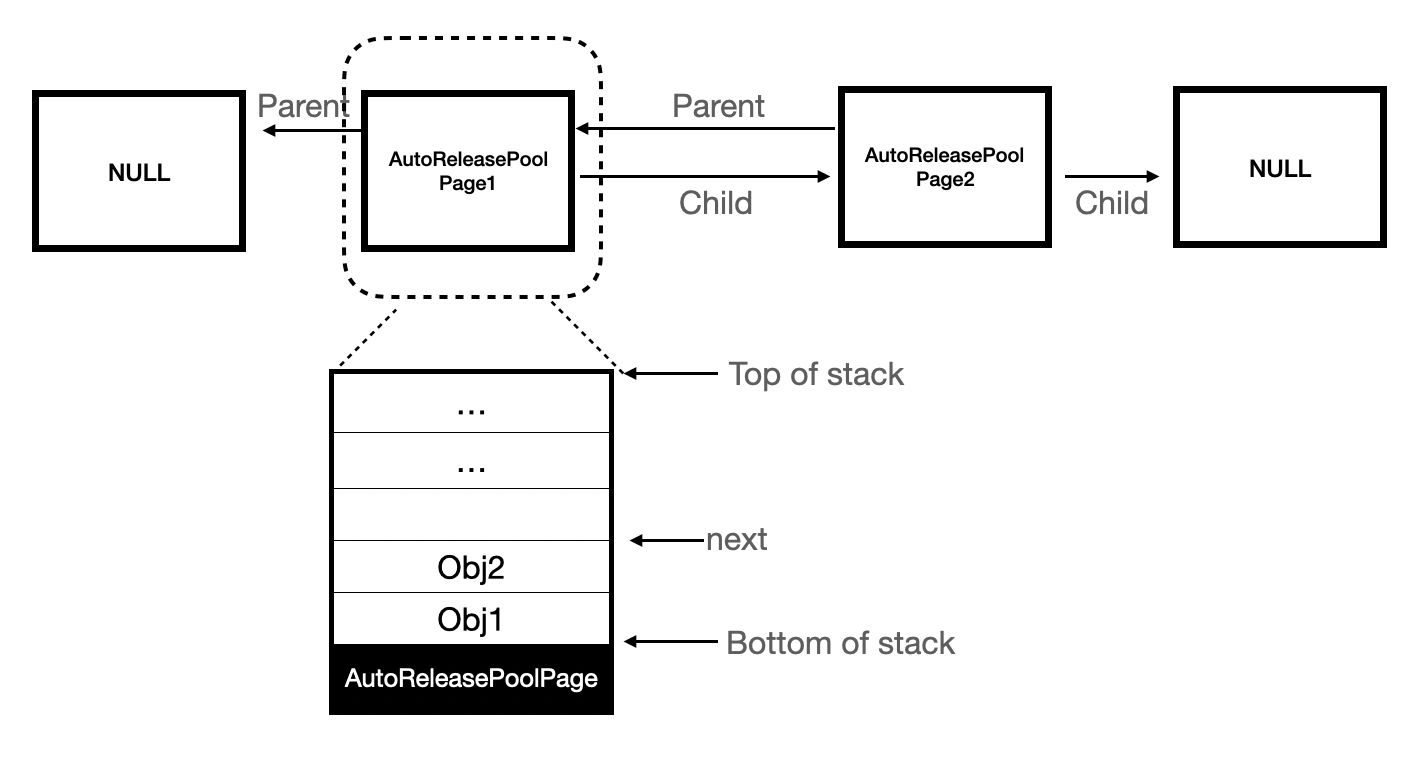
At end of a AutoReleasePool, AutoReleasePoolPage will pop objects in its stack and send [obj release] to them all.
Moreover, at the beginning of autoreleasepool, AutoReleasePoolPage will push a Sentinel object, which actually a nil object, to mark the beginning of current auto release pool. So we will only release objects up to the Sentinel object when we reach end of current auto release pool.

Follow up 2: How many AutoReleasePoolPage can a RunLoop have?
We can see from the AutoReleasePoolPage simplified definition below, each corresponds to one thread.
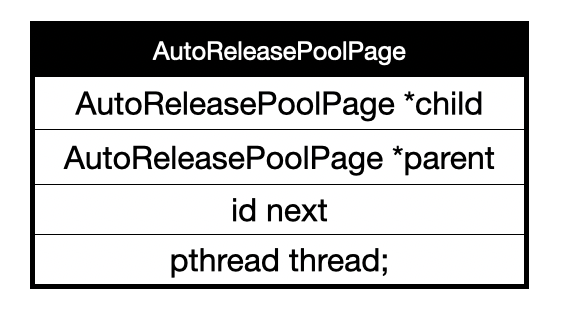
But in case one AutoReleasePoolPage can not fit all the autorelease objects, there would be more `AutoReleasePoolPage.
Follow up 3: When will object be released in AutoReleasePool?
- RunLoop will crate a AutoReleasePool at beginning of each loop, and destroy runloop at end of each loop.
- For user created AutoReleasePool, at end of the scope.
Follow up 4: Give me an example of using it?
```
for(int i=0;i<100;i++) {
UIView *view = [UIView new];
// do something
}
// do more thing
```For example, in the above code, many objects are created without deallocation, which will cause intense usage of memory. What we can do is to wrap the creation part with @autoreleasepool, so that objects will be released in time.
```
for(int i=0;i<100;i++) {
@autoreleasepool{
UIView *view = [UIView new];
// do something
}
}
// do more thing
```More on this in here and here.